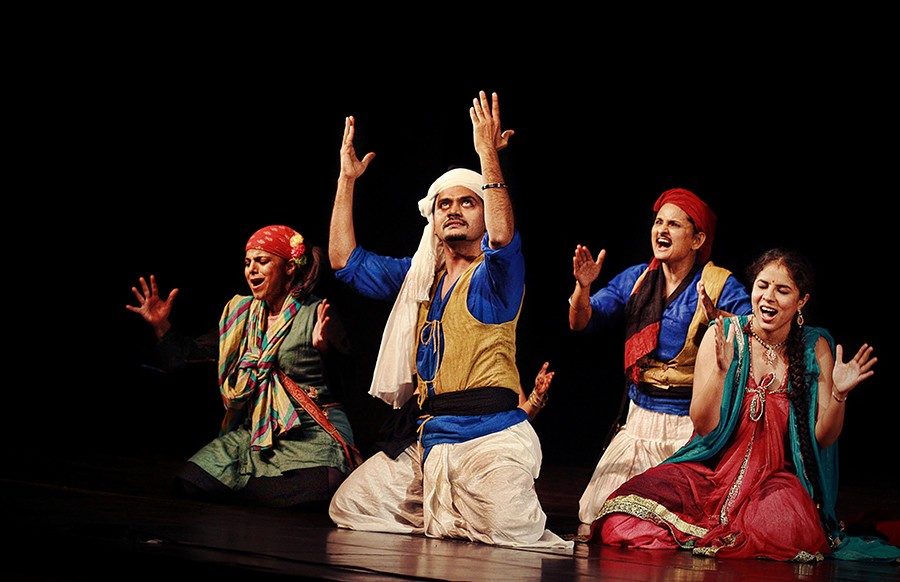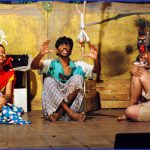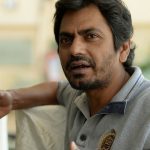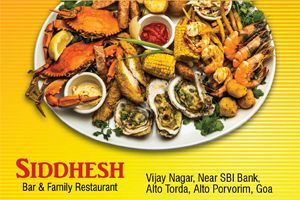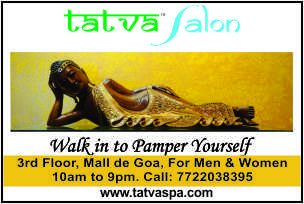Tanvi Bambolkar
Goa’s connection with theatre dates back to the ancient times when the local communities began to perform the folk theatre forms like Zagor, Ranmaalem etc. Folk theatre is without any written script yet includes all the visual and aesthetic aspects related to theatre. By taking inspiration from its indigenous theatre, and by getting influenced by western thoughts and theatrical developments, Goan theatre scene also evolved with time.
Today, the modern Goan theatre scenario can be categorized into three major types: 1) Commercial 2) Semi-commercial 3) Experimental. Tiatr, a popular theatre form can be considered as the only purely commercial theatre that runs in Goa. By commercial, it is implied that, this theatre thrives on the tickets which are sold, whereas Semi-commercial theatre is the one where groups are paid by local organizers to perform their plays. And an Experimental theatre, as the name suggest is solely experiment based theatre. Organization like Kala Academy has been organizing state level drama competition from several years which has largely contributed to the rise of experimental theatre in Goa.
Tiatr is a catholic dominated form and has a specific yet a large audience. It is believed that this form has evolved from the popular folk form called Khell (pronounced as Phell) in Salcete. It’s a street performance and due to its improvisation and oral nature has to be considered as a folk theatre form. However, the rise of Tiatr also has a connection to folk theatre form of Zagor. When Zagor were performed in Mumbai in 19th century, they were ridiculed for being vulgar. Thus, to provide more sophisticated form of entertainment, Tiatr was created.
Neighbouring state Maharashtra has the tradition of Sangeet Natak, the musical plays. These plays are specifically known for the songs which form a significant part of the plot. This tradition started off in Sangli taluka of Maharashtra in 1840s. Goa’s cultural scenario has been very much influenced by Maharashtra’s cultural elements. Sangeet Natak became really popular in Goa as well. It served as a hub of artists for Marathi theatre which was dominated by Sangeet Natak in earlier phases.
Even when the theatrical culture and folk theatre forms were present in Goa from a very long time, it took quite some time for Konkani theatre to flourish in Goan land. The first Konkani play was written by Bolantoor Krishnaprabhu in Bantwal, Karnataka in 1912 entitled Sangeet Chandrahas. Even in Goa, a lot of Marathi musical plays were translated into Konkani and staged. One such example is Sangeet Charudatta by Ravindra Kelekar which was based on Sangeet Mrichhakatik. Shenoi Goembab, the father of Konkani language used the medium of Konkani plays to assert the unique identity of Konkani. Adapting French comedy of Moliere into Konkani as Mogache Lagn and Abu Hasan’s tale from Arabian Nights as Jheelba Raano were some of his attempts at contributing in Konkani drama.
In the initial phases of Konkani drama, performances did not get much boost since Goan audience was more obsessed with Marathi drama. It was only after the liberation that conventional Konkani theatre received a boost due to attempts of various organizations. This era gave rise to experimental theatre in Goa. One of the major playwrights who experimented with themes and genres was Pundalik Naik.
Naik’s overall literature is influenced by the regional folklore. Goan folk songs have been a very significant part of Naik’s prose. He is one of the major contributors to the Konkani theatre as well.
In Konkani theatre, experimenting with folk theatre have been successfully carried out by playwrights like Punadalik Naik, Vinayak Khedekar, Dattaram Bambolkar, and directors such as Digambar Singbal, Shridhar Kamat Bambolkar, Pramod Mahableshwar. Pundalik Naik’s plays Shabai Shabai Bahujan Samaj, Prem Jagor, Chaitanyak Math Na, and Vinayak Khedekar’s Kani Kani Kotva are examples of such experiments. Along with these, Jayanti Naik’s Kukma Devichi Dipmal, Avinash Chari’s Kani Eke Kaniechi, Dattaram Bambolkar’s Mahiravan, Prasad Loliekar’s Krishnayan, are according to director Shridhar Bambolkar “all dramatic literary works which excel in their style because of their dependence on folk theatre, and have had great success on stage”
One of the plays by Pundalik Naik based on the traditional folk form Zagor is aptly titled as Premjagor has interestingly become an influence. It was originally a short story by Naik. He transcreated it into a play and was staged and presented by repertoire of Kala Academy in the year 1998. The play revolves around the life and love story of a Zagor performer Baburaay. He plays the role of thoti (limp) one of the characters from Zagor where one has to tie cane to one leg and dance. Baburaay in the process of impressing his lover’s father, tries to jump from one areca nut tree to another and falls down. This leads to him losing one of his legs thus turning him into limp in real life too. Thus, playwright has wisely utilized the significance of the character from folk theatre to foreshadow the fate of protagonist.
The play was once again staged by Antruz Lalitak in the year 2017. In this production, director Bambolkar has taken the liberty of taking some of the original songs from Zagor which are not a part of the script written by Naik. Interestingly, Bambolkar himself adapted Shakespeare’s Hamlet into Konkani as Sood Zagor in 2015 and was staged by the repertory of Kala Academy. The rat trap scene was made into a scene from Zagor in Sood Zagor. Also, the titles of both these plays, i.e. Premjagor and Sood Zagor asserts the presence of folk theatre form in their content and form.
In the Goan modern theatre scenario, a lot of experiments have been carried out to bring in the folk element in the modern drama. In the year 2016, an attempt was made by Abhivyaktee Panaji to organize a theatre festival called Lokrang which included three plays that were based on three different folk theatre forms of Goa. It was organized under ‘Performing Arts Grant Scheme’ of Arts and Culture Ministry of India. The first play which staged in this festival was Vedharan written by Anagha Deshpande and directed by Saish Deshpande. This play was based on Kaalo form. Playwright had retained some of the original songs from Kaalo and had converted some into satirical verses with contemporary content in them. The play was a commentary on the politics of language in the education sector of Goa. The protagonist of the play was Shankasur, the demon from Kaalo. Shankasur was portrayed as a politician who tries to impose his whims over his population and then falls into trouble.
The second play in Lokrang was Rupdyachi Rupkatha written by Vinayak Khedekar and directed by Shrikant Gaude. It was based on Perni Zagor. Although, the play was more of a realistic one, the use of masks in the setting and for one of the characters brought the play closer to the form of Perni Zagor.
Lokrang was concluded with Sabala Ga Naar written by Mahadev Joshi and directed by Abhay Jog. It was based on Ranmaalem. Out of all the three plays, this play was the most faithful to the folk form. Rather, the playwright claims that he has kept all the songs as they are in the original Ranmaalem. Also, director made the performers (who were not the traditional performers of Ranmaalem) learn the typical dance steps of Ranmaalem. A special training was given to them by the traditional Ranmaalem performers from Sattari. The only subversion which is done in the script is that the play focuses more on the female character’s perspective. It is the story of epic Ramayana. In the usual Ranmaalem, it is told in normal ways. Whereas, in Sabla Ga Naar the focus is the predicament of Urmila, wife of Laxmana and Kaikayi, mother of Ram who is often considered responsible for the sufferings of Ram.
Thus, it can be said that Goan theatre in spite of widening its horizons, is deeply rooted in its indigenous culture. It is largely influenced by its folk theatre. Also, Goan theatre is marching towards an age of experimentation with the support of its history and cultural legacy.


